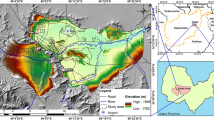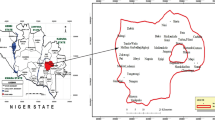Abstract
Suitability mapping for managed aquifer recharge is recently gaining more attention because of its potential in producing comprehensive maps easily interpreted and used by policy makers. In front of the divers existing methodologies, an adapted approach for the arid and semi-arid conditions of Tunisia was developed to generate a managed aquifer recharge (MAR) suitability and feasibility maps within a participatory approach with stakeholders. A Geographical Information Systems coupled with multi-criteria decision analysis (GIS-MCDA) was applied to establish the suitability and feasibility of MAR in Enfidha plain, NE of Tunisia. Selected criterions were spatialized under GIS thematic layers, and they were standardized based on literature and experts’ opinions regarding their importance in MAR implementation. Weights of each criterion were determined using analytic hierarchy process (AHP). Intrinsic suitability map was obtained using weighted linear combination (WLC) by the mean of ArcGIS software and via the INOWAS (innovative web-based decision support system for water sustainability under a changing climate) platform. It shows that more than 80% of the total plain area is intrinsically suitable and highly suitable for MAR. MAR feasibility map was established by overlaying intrinsic suitability, recharge water availability, and water demand maps of the region. It reveals that almost the fifth of the plain has high MAR feasibility potential. A decision support system (DSS) web-portal, namely, INOWAS, was finally used as an effective tool to store, share, and establish the MAR suitability maps with the concerned stakeholders.











Similar content being viewed by others
References
Adham MI, Jahan CS, Mazumder QH, Hossain MMA, Haque AM (2010) Study on groundwater recharge potentiality of Barind Tract, Rajshahi District, Bangladesh using GIS and remote sensing technique. J Geol Soc India 75(2):432–438
Ajjur SB, Baalousha HM (2021) A review on implementing managed aquifer recharge in the Middle East and North Africa region: methods, progress and challenges. Water Int 46(4):578–604
Aloui D (2019) Etude hydrogéologique du système aquifère de Chegarnia-Sidi Abiche (Enfidha, Sousse) : bilan hydrique et possibilités de recharge artificielle. Master degree dissertation, Faculty of Sciences of Bizerte, University of Carthage, p 105
Alraggad M, Jasem H (2010) Managed aquifer recharge (MAR) through surface infiltration in the Azraq basin/Jordan. J Water Resour Prot 2(12):1057
Andreo B, Vías J, Durán JJ, Jiménez P, López-Geta JA, Carrasco F (2008) Methodology for groundwater recharge assessment in carbonate aquifers: application to pilot sites in southern Spain. Hydrogeol J 16(5):911–925
Belghith Triki L, Boughrara L, Maalel F, Soussou A, Mattoussi R (2014) Contribution de la recharge artificielle à l’amélioration de la situation piézométrique du système aquifère de l’oued El Khairat. Internal report, Publ. General Direction of Water Resources, Ministry of Agriculture, Hydraulic Resources and Fisheries, Tunisia, p 32
Ben Haj Ali M, Jedoui Y, Dali T, Ben Salem H, Memmi L (1985) Geological map of Tunisia at the scale 1/500 000, ed. Serv. Géol., Tunisia
Bonilla JP, Stefan C (2019) Utilization of spatial analysis techniques for the identification of potential MAR areas: challenges and opportunities. Event report, 10th International Symposium on Managed Aquifer Recharge (ISMAR10). Madrid, Spain, May 20–24, 2019
Bonilla Valverde J, Blank C, Roidt M, Schneider L, Stefan C (2016) Application of a GIS multi-criteria decision analysis for the identification of intrinsic suitable sites in Costa Rica for the application of managed aquifer recharge (MAR) through spreading methods. Water 8(9):391
Bouri S, Dhia HB (2010) A thirty-year artificial recharge experiment in a coastal aquifer in an arid zone: the Teboulba aquifer system (Tunisian Sahel). C R Geosci 342(1):60–74
Chekirbane A, Aloui D, El Euchi I, Mejri S, Lachaal F, Khadhar S, Mlayah A (2018) Assessment of managed aquifer recharge by hill dam water release: case of the groundwater flow systems at Wadi Saadine and Wadi Khairat watersheds, NE of Tunisia. Sixth International Water Forum Conference 2018. March 19 -21, Hammamet, Tunisia
Chekirbane A, Aloui D, El Euchi I, Mejri S, Khadhar S, Lachaal F, Tsujimura M, Zghibi A, Mlayah A (2019) Tunisian experience in Managed Aquifer Recharge (MAR) by hill dam water release: case of some groundwater flow systems in North of Tunisia. 10th International Symposium for Managed Aquifer Recharge ISMAR 10. 20 – 24 May, Madrid, Spain
Chenini I, Mammou AB, El May M (2010) Groundwater recharge zone mapping using GIS-based multi-criteria analysis: a case study in Central Tunisia (Maknassy Basin). Water Resour Manage 24(5):921–939
Chowdhury A, Jha MK, Chowdary VM (2010) Delineation of groundwater recharge zones and identification of artificial recharge sites in West Medinipur district, West Bengal, using RS, GIS and MCDM techniques. Environ Earth Sci 59(6):1209
DGRE (General Direction of Water Resources DGRE) (2015) Artificial recharge of Tunisian aquifers. Internal report. Publ. Ministry of Agriculture, Hydraulic Resources and Fisheries, Tunisia
Dillon P, Stuyfzand P, Grischek T, Lluria M, Pyne RDG, Jain RC, Bear J, Schwarz J, Wang W, Fernandez E, Stefan C (2019) Sixty years of global progress in managed aquifer recharge. Hydrogeol J 27(1):1–30
Dillon PJ, Pavelic P, Page D, Beringen H, Ward J (2009) Managed aquifer recharge. An introduction waterlines report series. (13)
El Euchi I (2016) Evaluation de la recharge de la nappe de l’underflow d’oued El Khairat à partir des lâchers de barrage. [Groundwater recharge assessment in Khairat aquifer from dam water release]. Master thesis. National Institute of Agronomy, University of Carthage, Tunisia
Famiglietti JS (2014) The global groundwater crisis. Nat Clim Chang 4(11):945–948
Fathi S, Hagen JS, Haidari AH (2020) Synthesizing existing frameworks to identify the potential for Managed Aquifer Recharge in a karstic and semi-arid region using GIS Multi Criteria Decision Analysis. Groundw Sustain Dev 11:100390
Feizizadeh B, Blaschke T (2014) An uncertainty and sensitivity analysis approach for GIS-based multicriteria landslide susceptibility mapping. Int J Geogr Inf Sci 28(3):610–638
Fenta AA, Kifle A, Gebreyohannes T, Hailu G (2015) Spatial analysis of groundwater potential using remote sensing and GIS-based multi-criteria evaluation in Raya Valley, northern Ethiopia. Hydrogeol J 23(1):195–206
Furukawa M (2012) Groundwater and surface water cycle system in inland and coastal watersheds, northern Tunisia. Master thesis. Faculty of Life and Environmental Sciences, University of Tsukuba, Japan
Gaaloul N, Pliakas F, Kallioras A, Schuth C, Marinos P (2012) Simulation of seawater intrusion in coastal aquifers: forty-five-years exploitation in an eastern coast aquifer in NE Tunisia. Open Hydrol J 6:31–44
Gdoura K, Anane M, Jellali S (2015) Geospatial and AHP-multicriteria analyses to locate and rank suitable sites for groundwater recharge with reclaimed water. Resour Conserv Recycl 104:19–30. https://doi.org/10.1016/j.resconrec.2015.09.003
Gorelick SM, Zheng C (2015) Global change and the groundwater management challenge. Water Resour Res 51(5):3031–3051
Greene R, Devillers R, Luther JE, Eddy BG (2011) GIS-based multiple-criteria decision analysis. Geogr Compass 5(6):412–432
Kallali H, Anane M, Jellali S, Tarhouni J (2007) GIS-based multi-criteria analysis for potential wastewater aquifer recharge sites. Desalination 215(1–3):111–119
Karami GH, Bagheri R, Rahimi F (2016) Determining the groundwater potential recharge zone and karst springs catchment area: Saldoran region, western Iran. Hydrogeol J 24(8):1981–1992
Ketata M, Gueddari M, Bouhlila R (2014) Hydrodynamic and salinity evolution of groundwaters during artificial recharge within semi-arid coastal aquifers: a case study of El Khairat aquifer system in Enfidha (Tunisian Sahel). J Afr Earth Sci 97:224–229
Magesh NS, Chandrasekar N, Soundranayagam JP (2012) Delineation of groundwater potential zones in Theni district, Tamil Nadu, using remote sensing GIS and MIF techniques. Geosci Front 3(2):189–196
Mahmoud SH (2014) Delineation of potential sites for groundwater recharge using a GIS-based decision support system. Environ Earth Sci 72(9):3429–3442
Malczewski J (2006) GIS-based multicriteria decision analysis: a survey of the literature. Int J Geogr Inf Sci 20(7):703–726
Malczewski J, Rinner C (2015) Multicriteria decision analysis in geographic information science. Springer, New York, pp 90–93
Manaa M, Chaieb H, Amri R (1996) Etude par modèle hydrogéologique de la nappe alluviale d’Oued El Khairat. [A study by hydrogeological model of the alluvial aquifer of Wadi Khairat], Internal report, Publ. General Direction of Water Resources, Ministry of Agriculture, Hydraulic Resources and Fisheries, Tunisia, p 31
Margat J, Van der Gun J (2013) Groundwater around the world: a geographic synopsis. CRC Press/Balkema. https://doi.org/10.1201/b13977
Masciopinto C (2013) Management of aquifer recharge in Lebanon by removing seawater intrusion from coastal aquifers. J Environ Manage 130:306–312
Mekni A, Souissi A (2016) The effectiveness of artificial recharge by treated wastewater in combating seawater intrusion-The case study of Korba-El Mida aquifer (Cape bon, Tunisia). Int J Innov Appl Stud 15(2):264
Msaddek MH, Souissi D, Moumni Y, Chenini I, Dlala M (2017) Integrated multi-criteria evaluation and weighted overlay analysis in assessment of groundwater potentiality in Segui Region, Southern Tunisia. In: Euro-Mediterranean Conference for Environmental Integration. Springer, Cham, pp 631–632
Mukherjee P, Singh CK, Mukherjee S (2012) Delineation of groundwater potential zones in arid region of India—a remote sensing and GIS approach. Water Resour Manage 26(9):2643–2672
Oikonomidis D, Dimogianni S, Kazakis N, Voudouris K (2015) A GIS/remote sensing-based methodology for groundwater potentiality assessment in Tirnavos area, Greece. J Hydrol 525:197–208
Page D, Bekele E, Vanderzalm J, Sidhu J (2018) Managed aquifer recharge (MAR) in sustainable urban water management. Water 10(3):239
Pedrero F, Albuquerque A, do Monte HM, Cavaleiro V, Alarcón JJ (2011) Application of GIS-based multi-criteria analysis for site selection of aquifer recharge with reclaimed water. Resour Conserv Recycl 56(1):105–116
Rahman MA, Rusteberg B, Gogu RC, Ferreira JL, Sauter M (2012) A new spatial multi-criteria decision support tool for site selection for implementation of managed aquifer recharge. J Environ Manage 99:61–75
Saaty TL (1990) How to make a decision: the analytic hierarchy process. Eur J Oper Res 48(1):9–26
Sallwey J, Bonilla Valverde JP, Vásquez López F, Junghanns R, Stefan C (2018) Suitability maps for managed aquifer recharge: a review of multi-criteria decision analysis studies. Environ Rev 27(2):138–150
Sener E, Davraz A, Ozcelik M (2005) An integration of GIS and remote sensing in groundwater investigations: a case study in Burdur, Turkey. Hydrogeol J 13(5–6):826–834
Shaban A, Khawlie M, Abdallah C (2006) Use of remote sensing and GIS to determine recharge potential zones: the case of Occidental Lebanon. Hydrogeol J 14(4):433–443
Singh A, Panda SN, Kumar KS, Sharma CS (2013) Artificial groundwater recharge zones mapping using remote sensing and GIS: a case study in Indian Punjab. Environ Manage 52(1):61–71
Souissi D, Msaddek MH, Zouhri L, Chenini I, El May M, Dlala M (2018) Mapping groundwater recharge potential zones in arid region using GIS and Landsat approaches, southeast Tunisia. Hydrol Sci J 63(2):251–268
Stefan C, Ansems N (2018) Web-based global inventory of managed aquifer recharge applications. Sustain Water Resour Manag 4(2):153–162
Sukumar S, Sankar K (2010) Delineation of potential zones for artificial recharge using GIS in Theni district, Tamilnadu, India. Int J Geomatics Geosci 1(3):639
van der Gun J (2021) Groundwater resources sustainability. In: Mukherjee A, Scanlon BR, Aureli A, Langan S, Guo H, McKenzie AA (eds) Chapter 24 - global groundwater. Elsevier, pp 331–345. https://doi.org/10.1016/B978-0-12-818172-0.00024-4
Zammouri M, Brini N, Horriche FJ (2018) Assessment of artificial recharge efficiency against groundwater stress in the El Khairat aquifer. In: Groundwater and Global Change in the Western Mediterranean Area. Springer, Cham, pp 305–312
Zghibi A, Mirchi A, Msaddek MH, Merzougui A, Zouhri L, Taupin JD, Chekirbane A, Chenini I, Tarhouni J (2020) Using analytical hierarchy process and multi-influencing factors to map groundwater recharge zones in a semi-arid Mediterranean coastal aquifer. Water 12(9):2525
Author information
Authors and Affiliations
Contributions
We would like to state that regardless their order in the authors list, first (Dorsaf Aloui) and second authors (Anis Chekirbane) have equally contributed to this paper preparation.
Corresponding author
Ethics declarations
Conflict of interest
The authors declare no competing interests.
Additional information
Responsible Editor: Fethi Lachaal
This article is part of the Topical Collection on Water Quality, Global Changes and Groundwater Responses
Rights and permissions
About this article
Cite this article
Aloui, D., Chekirbane, A., Stefan, C. et al. Use of a GIS-multi-criteria decision analysis and web-based decision support tools for mapping and sharing managed aquifer recharge feasibility in Enfidha plain, NE of Tunisia. Arab J Geosci 15, 658 (2022). https://doi.org/10.1007/s12517-022-09893-8
Received:
Accepted:
Published:
DOI: https://doi.org/10.1007/s12517-022-09893-8




